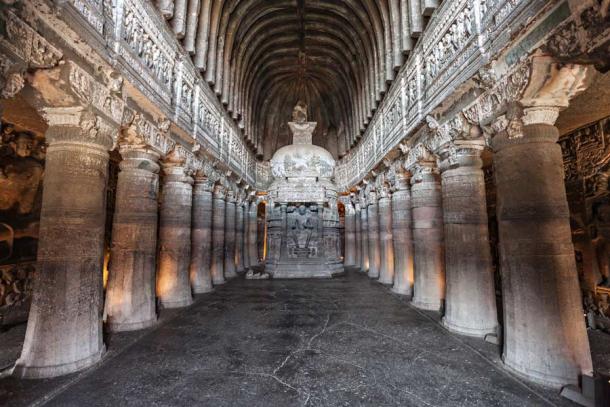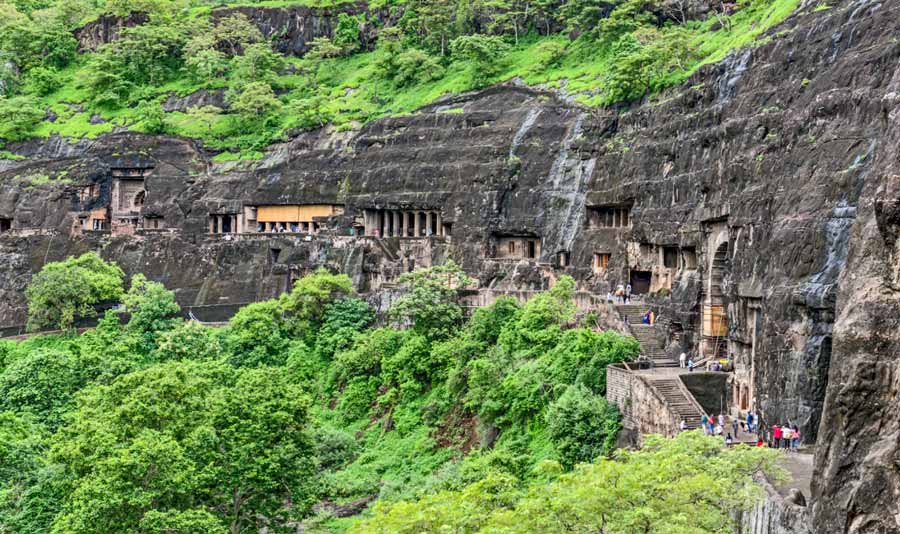The Wondrous Buddhist Rock-Cut Architecture of the Ajanta Caves
It was in 1819 when John Smith, a British army officer in pursuit of a tiger came across a cave near Ajanta village in India. More than thirty caves carved inside the rock of the mountainside and arranged in a horseshoe shape—the well-known Ajanta Caves—have now been discovered in that area. These Buddhist rock-cut caves are believed to have been constructed around 200 BC and were used as retreat places for Buddhist monks during the monsoon season. The caves were abandoned after the 7th century AD when Buddhism declined in India, but are still considered sacred by locals.

Carved Buddha inside one of the rock-cut Ajanta caves in India. (Rafal Cichawa / Adobe Stock)
Ajanta Caves: Fabulous Buddhist Rock-Cut Architecture
Located on a cliff overlooking the Waghora River in the Ajanta hills of the state of Maharashtra in western India, the Ajanta caves are connected to the river via staircases cut into the granite cliffs. The majority of the thirty Ajanta caves are sangharamas or viharas (monastery caves used for gatherings with apartments used as the residence of monks), while five are chaityagrihas (sanctuary caves). Some were created during the Satavahana dynasty from about 200 BC, while others were carved into the rock in the 5th and 6th centuries AD.
- The Architecture and Spiritual History of India’s Famous Barabar Caves
- The Sacred Bavikonda Monastery: Vestiges of the Buddhist Golden Age in India
The Ajanta Caves were once an important center of Buddhist teaching as well as a pilgrimage site. During their use, the caves were expanded and decorated. They are full of beautiful mural paintings and create a serene atmosphere for the visitor. Many of the paintings and sculptures depict the life of Buddha, as well as his previous incarnations, known as Jatakas, as well as paintings which tell of Buddhist legends and divinities. However, an interesting feature is that the number of female depictions is as abundant as the males. To the common viewer, images of semi-naked women in caves used as monk retreats can be unusual.
Paintings with half men, half animal depictions are also present. We know that all over the world similar depictions appear in almost all myths and religions, but again the question is why here? Is it possible all of them “imagined” these things, or used them allegorically to depict something else? Or is it possible that those beings did exist in ancient times, and if yes, who made them and where were they from?

Interior of one of the Ajanta caves in India. (matiplanas / Adobe Stock)
Arrangement of Ajanta Caves is Linked to the Solstices
Some researchers have proposed that the arrangement of the caves is not just random. A few dome-shaped caves contain stupas with the Buddha carved in them, and some researchers suggest that they are arranged in such a way as to be in line with solstices. One in particular, cave 19, is oriented to the winter solstice, and on that day the sun goes through the opening on the top front of the cave and illuminates the stupa in the back.
Similarly, cave 26 is oriented to the summer solstice so that, on that particular day, the sun will illuminate the stupa in this cave. Precise calculations and tools would have been needed to be able to orient the caves to the solstices since the caves are carved inside the rock.
The stupas were designed to be used as a way for Buddha to ascend to the heavens—and in some cases doors were attached to them. Some have claimed that the Stupas were some kind of flying machines for Buddha to literally ascend into the heavens. Others believe that some form of technology was used in the construction of the network of caves. For now, it remains a mystery.
- Shelters from the Storm: More Ancient Buddhist Caves Found in Mumbai
- Bojjannakonda, India: The Hill of the Buddha Where Kings and Nobles Donated Countless Treasures
The Ajanta caves are a stunning example of Buddhist rock-cut architecture, and are evidence of the importance of Ajanta as an important hub of Buddhist culture in ancient times. They are managed by the Archeological Survey of India and were designated a UNESCO World Heritage Site in 1983. Although some of them are over 2000 years old, The Indian Express bemoans that “lack of conservation efforts, poor restoration, and the ravages of time have ensured that only a small part of the 30-odd caves and its beautifully expressive paintings can be admired.”
Caused by climatic conditions and the growth of vegetation, as well as structural damage, their state of conservation is also caused by human factors such as graffiti, unprofessional cleaning methods, over-tourism and negligence. Even John Smith, who discovered the caves, vandalized one of the ancient murals by engraving his name on top of it.

Interior of a Ajanta chaityagrihas, or sanctuary cave, at the Ajanta caves.(saiko3p / Adobe Stock)
Visiting Ajanta Caves
The closest airport to the Ajanta caves is Aurangabad Airport, just 99 km (61.5 mi) away. The caves are open all year round from 9 a.m. to 5.30 p.m., but closed on Mondays. You can book tickets online at the Ministry of Culture website. It’s best to visit between November and March, when the weather is dry and cool. Bring a torch as the lighting in the caves is poor.
Top image: The Ajanta caves in India. Source: mukulbanerjee / Adobe Stock
By Ancient Origins
References
Banerjee, S. 20 December 2018. “Know Your Monument: The Ajanta Caves” in The Indian Express. Available at: https://indianexpress.com/article/parenting/events-things-to-do/monument-ajanta-caves-5500095/
Behl. B. K. & Beach, M. C. 2005. The Ajanta Caves: Ancient Paintings of Buddhist India. Thames and Hudson Ltd.
Dhavalikar, M. K. 2005. Ellora. Oxford University Press.
No name. 5 November 2010. “The Ajanta Caves – Ancient Temples Carved from Rock” in Kuriositas. Available at: https://www.kuriositas.com/2010/11/ajanta-caves-ancient-temples-carved.html
No name. No date. “Ajanta Caves” in UNESCO. Available at: http://whc.unesco.org/en/list/242
No name. No date. Information portal on Ajanta & Ellora Caves. Available at: http://ajantacaves.com/

















